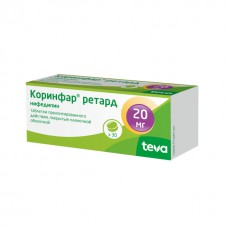Expiration date: 01/2025
Composition and form of release:
Tablets, prolonged action, film-coated 1 tablet.
active substance:
nifedipine 20 mg
excipients: lactose monohydrate — 31, 6 mg, potato starch — 31, 4 mg MKC — 31 mg magnesium stearate — 0, 6 mg povidone K25 — 5, 4 mg
the film shell: hypromellose — 5, 188 mg, macrogol 6000 — 5, 4 mg macrogol 35000 — 5, 4 mg of the dye quinoline yellow (E104) — 0, 143 mg titanium dioxide (E171) — 1, 377 mg talc — 1, 038 mg
in a blister made of PVC / aluminum 10 pcs. in a pack of cardboard 3 blisters, or in bottles of brown glass with a white cork made of LDPE with a relief inscription "AWD" of 50 or 100 pcs. there is 1 bottle in a carton pack.
Description of the dosage form:
Corinfar: round, biconvex yellow tablets, film-coated, with beveled edges. Tablets of the same type.
View in the fracture: a homogeneous mass of yellow color.
Corinfar retard: round, biconvex yellow tablets, film-coated, with solid edges and the same appearance.
View in the fracture: a homogeneous mass of yellow color.
Characteristic:
Selective blocker of "slow" calcium channels, a derivative of 1,4-dihydropyridine.
Pharmacological action:
Reduces the flow of extracellular Ca2+ into cardiomyocytes and smooth muscle cells of coronary and peripheral arteries in high doses inhibits the release of Ca2+ from intracellular depots. In therapeutic doses, it normalizes the transmembrane current Ca2+, which is disrupted in a number of pathological conditions, primarily in hypertension.
Pharmacokinetics:
Absorption is high (more than 90%). Bioavailability — 50-70%. Simultaneous food intake delays, but does not reduce the absorption of nifedipine from the gastrointestinal tract. Eating increases bioavailability. It has the effect of "first passage" through the liver. The cmax of nifedipine in blood plasma is on average 28.3 ng / ml and after a single oral administration 2 tab. Corinfar (corresponding to 20 mg of nifedipine) is achieved in 1-3 hours, after taking 1 table. Corinfar retard (20 mg of nifedipine) - after 0, 9-3, 7 hours Penetrates through the BBB and placental barrier, is excreted in breast milk. Binding to plasma proteins (albumins) - 95%. It is completely metabolized in the liver. It is excreted by the kidneys as an inactive metabolite (60-80% of the dose taken). 20-40% - with bile. T1/2 is 2-5 h. There is no cumulative effect. Chronic renal failure, hemodialysis and peritoneal dialysis do not affect pharmacokinetics. In patients with hepatic insufficiency, the total clearance decreases and T1/2 increases.
Description of pharmacological action:
Enhances coronary blood flow, improves blood supply to ischemic areas of the myocardium without the development of the phenomenon of "stealing", activates the functioning of collaterals. By expanding peripheral arteries, it reduces heart rate, myocardial tone, postload and oxygen demand. Practically does not affect the sinoatrial and AV nodes, has weak antiarrhythmic activity. Increases renal blood flow, causes moderate natriuresis. Negative chrono-, dromo- and inotropic effects are overlapped by reflex activation of the sympathoadrenal system and an increase in heart rate in response to peripheral vasodilation. It does not affect the tone of the veins.
The time of onset of the clinical effect is 20 minutes, its duration is 4-6 hours.
Indications:
Chronic stable angina pectoris (tension angina pectoris), vasospastic angina pectoris (Prinzmetal angina pectoris, variant angina pectoris), essential hypertension.
Contraindications:
Hypersensitivity to nifedipine and other derivatives of 1,4-dihydropyridine, arterial hypotension (SAD below 90 mmHg), cardiogenic shock, severe aortic stenosis, unstable angina pectoris, acute period of myocardial infarction (during the first 4 weeks), pregnancy, breast-feeding.
Use with caution in patients with severe mitral valve stenosis, hypertrophic obstructive cardiomyopathy, severe bradycardia or tachycardia, sinus node weakness syndrome, heart failure, mild or moderate arterial hypertension, severe cerebral circulatory disorders, myocardial infarction with left ventricular insufficiency, gastrointestinal obstruction, renal and hepatic insufficiency, patients on hemodialysis (due to risk of arterial hypotension) and children under 18 years of age (efficacy and safety have not been established).
Side effect:
From the cardiovascular system: tachycardia, arrhythmia, peripheral edema (ankles, feet, shins), manifestation of excessive vasodilation (asymptomatic decrease in blood pressure, flushes of blood to the face, a feeling of heat), pronounced decrease in blood pressure (rarely), syncope, heart failure (more often - an increase in signs of already existing).
From the nervous system: headache, dizziness, general weakness, fatigue, drowsiness.
From the digestive system: dyspepsia (nausea, diarrhea or constipation), dry mouth, increased appetite.
Allergic reactions: rarely - itching, urticaria, exfoliative dermatitis.
Drug interaction:
With the simultaneous use of other antihypertensive agents, as well as tricyclic antidepressants, nitrates, cimetidine (ranitidine and famotidine do not significantly affect the metabolism of BCC), inhaled anesthetics, diuretics, the hypotensive effect of nifedipine may increase.
When combining nifedipine with nitrates, tachycardia increases.
Diltiazem suppresses the metabolism of nifedipine in the body and with the simultaneous administration of these drugs, it may be necessary to reduce the dose of nifedipine.
Reduces the concentration of quinidine in plasma.
Increases the concentration of digoxin and theophylline in plasma.
Rifampicin accelerates the metabolism of nifedipine, which requires a change in the dose of nifedipine.
Ethanol can enhance the hypotensive effect.
With simultaneous administration with cephalosporins (for example, cefixime), the bioavailability of cephalosporins may increase by 70%.
Sympathomimetics, NSAIDs (suppression of prostaglandin synthesis in the kidneys and retention of sodium ions and fluid in the body), estrogens (fluid retention in the body) reduce the hypotensive effect.
Nifedipine suppresses the metabolism of prazosin and other alpha-blockers, which can lead to an increased hypotensive effect.
Nifedipine inhibits the elimination of vincristine from the body and can cause an increase in the side effects of vincristine (if necessary, the dose of vincristine is reduced).
Grapefruit juice suppresses the metabolism of nifedipine in the body, and therefore it is contraindicated to use it with nifedipine.
Method of administration and dosage:
Inside, after eating, without chewing and drinking enough liquid. Simultaneous food intake delays, but does not reduce the absorption of the active substance from the gastrointestinal tract.
The doctor selects the doses of the drug individually in accordance with the severity of the disease and the sensitivity of the patient to the drug. For patients with concomitant severe cerebrovascular diseases and in elderly patients, the dose should be reduced.
Recommended dosage regimen for adults
Chronic stable and vasospastic angina pectoris: 20 mg (1 table) 2 times a day. With an insufficiently pronounced clinical effect, the dose of the drug is gradually increased to 40 mg (2 tables) 2 times a day. The maximum daily dose is 80 mg (4 tables).
Essential hypertension: 20 mg (1 table) 2 times a day. With an insufficiently pronounced clinical effect, the dose of the drug is gradually increased to 40 mg (2 tables) 2 times a day. The maximum daily dose is 80 mg (4 tables).
With 2-fold administration of the drug per day, the interval between doses should be on average 12 hours. The minimum interval between doses of the drug is at least 4 hours.
The duration of the course of treatment is determined by the attending physician.
In cases where the drug is taken in large doses and / or for a long time, treatment should be discontinued gradually in order to avoid withdrawal syndrome.
Overdose:
Symptoms: headache, hyperemia of the facial skin, prolonged pronounced decrease in blood pressure, depression of the sinus node function.
Treatment: symptomatic. In case of severe poisoning (collapse, sinus node depression), gastric lavage (if necessary, small intestine) is performed, activated charcoal is prescribed. The antidote is calcium preparations, an intravenous injection of 10% calcium chloride or calcium gluconate is indicated, followed by switching to a long-term infusion.
With a marked decrease in blood pressure, slow intravenous administration of dopamine, dobutamine, adrenaline or norepinephrine is indicated. It is recommended to monitor the content of glucose in the blood (the release of insulin may decrease) and electrolytes. With the development of heart failure - intravenous administration of strophanthin. In case of conduction disorders — atropine, isoprenaline or an artificial pacemaker. It is recommended to monitor the blood glucose and electrolytes (K+, Ca2+). Hemodialysis is not effective.
Precautions:
During the treatment period, it is necessary to refrain from engaging in potentially dangerous activities that require increased concentration and speed of psychomotor reactions, as well as from the use of ethanol.
For patients over 60 years of age, the dose of the drug is selected with caution. Withdrawal of the drug is carried out gradually (risk of withdrawal syndrome).
Special instructions:
During treatment, positive results of a direct Coombs reaction and laboratory tests for antinuclear antibodies are possible.



